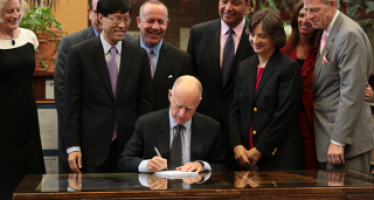Five candidates for California State University Chancellor
May 31, 2012
By John Hrabe
After fourteen years as head of the nation’s largest higher education system, Cal State University Chancellor Charles Reed is calling it quits. Reed’s tenure has been praised by the insular higher education community. He’s been one of the most vocal protectors of the status quo, which enriches the bureaucratic elite at the expense of students and faculty.
 “In my four years in California, the Chancellor has been an effective and reliable ally in the fight to keep alive for future generations of Californians the promise of an affordable, top quality education,” said Mark Yudof, president of the University of California, according to “Testaments to Chancellor Charles B. Reed’s Service,” a glowing piece of bureaucratic propaganda produced by the Chancellor’s office. “We have worked as partners in Sacramento, attempting to persuade the state’s political leadership to reverse its chronic disinvestment in public higher education.”
“In my four years in California, the Chancellor has been an effective and reliable ally in the fight to keep alive for future generations of Californians the promise of an affordable, top quality education,” said Mark Yudof, president of the University of California, according to “Testaments to Chancellor Charles B. Reed’s Service,” a glowing piece of bureaucratic propaganda produced by the Chancellor’s office. “We have worked as partners in Sacramento, attempting to persuade the state’s political leadership to reverse its chronic disinvestment in public higher education.”
To his critics, Reed is to blame for reckless spending, endless tuition increases, a contentious relationship with faculty and an embarrassing executive compensation scandal. “Chancellor Reed has presided over an era of unprecedented turmoil in the California State University system,” read a statement from the California Faculty Association upon Reed’s retirement announcement. “The CSU has seen devastating budget cuts, and students have borne much of the burden – student fees have more than quadrupled since 2002.”
Prop Zero blogger Joe Mathews recently suggested that Los Angeles Angels of Anaheim first baseman Albert Pujos take over the job. “Maybe he could be convinced to work days at Cal State headquarters in Long Beach for free, before making the short drive to Anaheim for night games,” he wrote. That got us to speculating about other scenarios, some just as unlikely, for filling the job of Cal State Chancellor.
The Favorites
Scenario #1: The Cal State Insider
Candidates: Cal State Vice-Chancellors: Benjamin Quillian, Ephraim Smith & Gail Brooks
Rationale: If you thought the Augusta National Golf Club was exclusive, you’ve never reviewed the resumes on file in Cal State’s HR department. Or, for any academics out there, Cal State is susceptible to in-group–out-group bias. “Each group nourishes its own pride and vanity, boasts itself superior, exists in its own divinities, and looks with contempt on outsiders,” observed sociologist William Sumner, according to Wikipedia.
Cal State loves to promote from within. New Cal State Northridge president Dianne Harrison previously served as president of Monterey Bay. San Jose State President Mohammad Qayoumi’s used to hold the same position at East Bay. We could go on and on. That’s why the safe bet is that after a long and expensive executive search firm completes their review, Cal State will promote one of the system’s vice-chancellors. Moreover, we aren’t exactly sure that any out-of-state education administrator could be persuaded to take the job.
Downside: Status Quo. Cal State could expect more of the same dysfunction and fiscal mismanagement if it promoted from within the organization. In 1990, after CSU Chancellor Ann Reynolds resigned in disgrace following her own executive pay scandal, an executive vice chancellor took over the job on an interim basis. The chief deputy, Herbert Carter, would go on to serve as Chairman of the Board of Trustees, until the State Senate blocked his reconfirmation earlier this year.
Odds: 4 to 1
Scenario #2: Out-of-State Higher Education Administrator
Candidates: William E. Kirwan, Chancellor of the University System of Maryland; Frank T. Brogan, Chancellor of the State University System of Florida
Rationale: Cal State’s out-of-state farm system has training camps in Maryland and Florida. From 1985 to 1998, Reed served as chancellor of the State University System of Florida. Cal State plucked Elliot Hirschman from the University of Maryland last year to fill the void at San Diego State. As further evidence of Cal State’s Maryland connections, the universities worked out a 2008 memorandum of understanding for assisting servicemembers with completing their degrees.
Downside: An out-of-state administrator wouldn’t be much better than a Cal State insider. They’d look at Cal State’s budget problems as a forced choice between tuition increases and enrollment cuts. These individuals wouldn’t necessarily replicate Cal State’s reckless spending practices, but they could be expected to appease the institution.
Odds: 25 to 1. We doubt either one of these administrators would want the job. Why join the Cal State University system as it prepares for catastrophic budget cuts in the fall? Moreover, Cal State would likely disapprove of Brogan’s political affiliation; he served as Jeb Bush’s Lt. Governor.
A Stretch, But Still Plausible
Scenario #3: A Rotating Position
Candidates: Cal State Presidents
Rationale: In response to Reed’s retirement, the California Faculty Association suggested, “This ‘changing of the guard’ provides a unique opportunity to reflect on the direction of the CSU, and to improve the quality of education at the nation’s largest university system.” So, what’s unique and out-of-the-box, according to one of those high-priced consulting firms that would likely be paid to conduct an executive search? One idea might be to rotate the Chancellor position among the Cal State presidents.
College presidents are essentially mini-me’s of the system-wide chancellor. The job responsibilities are the same: to raise money, to negotiate with faculty and to act as the public face of the college. By rotating the position, Cal State presidents would begin to think more collectively about the system’s problems, instead of focusing exclusively on what’s best for each individual campus. That might produce more cost-saving partnerships among Cal State universities. For example, Dominguez Hills could merge a few course sections with Long Beach State. You’d also save money by eliminating the salary of one of the highest-paid state employees, thereby blunting further executive compensation criticism.
Downside: Cal State presidents would probably tell you that they’ve already got enough on their plate. Instead of using the position to think collectively about the good of the system, presidents might use the Cal State Chancellor’s office to funnel money back to their individual campus.
Odds: 6,839 to 1
When Pigs Fly and Hell Freezes Over
Scenario #4: The Cal State Critic
Candidates: Asm. Anthony Portantino; Sen. Leland Yee
Rationale: In one move, the Cal State Board of Trustees could effectively end all criticism of its executive compensation policies. What better way to silence your critics than to hire one of them to run the place? Yee and Portantino have impeccable legislative records defending Cal State from budget cuts. They’re well-respected by the faculty association, which has been unhappy with the current administration. Plus, this choice could unify Cal State Trustees in their push for the November tax increases. (Not that CalWatchdog supports tax hikes.) Their message about dire budget cuts wouldn’t be muddled by wasteful spending by the Chancellor’s office.
Sen. Yee is the ideal candidate to serve as the new Chancellor of the Cal State University. He meets all the requirements: he spent eight years on the San Francisco Unified School District Board of Education, has a doctorate in child psychology and showed his fundraising prowess in the San Francisco mayor’s race. He’s about the only outsider who has the qualifications to immediately fill a higher education leadership position. There’s also a precedent of a legislator serving as chancellor. Former State Senator Jack Scott most recently served as chancellor of the California Community College system.
Downside: It’s easier to criticize than govern. Although Portantino and Yee are highly effective legislators, some administrators would argue that they lack the necessary administrative experience.
Odds: 44,000 to 1. This scenario is pretty far-fetched, but only because of personality conflicts. The Cal State Trustees and bureaucrats despise these government watchdogs. Earlier this year, the pair sent a letter to the Chancellor’s office demanding the truth about Cal State’s executive pay. An Assistant Vice Chancellor replied, “Not sure we felt it was necessary to respond to the ongoing and never ending critical communications.” Yet, this scenario is still more likely than the final option.
Scenario #5: Higher Education Revolutionary
Candidates: Salman Khan, Peter Thiel, Sebastian Thrun
Rationale: Entrepreneur and businessman Mark Cuban predicts that higher education will experience a collapse in the next decade far worse than the housing market debacle. “Like the real estate industry, prices will rise until the market revolts,” he wrote on his blog. Khan, Thiel and Thrun are education revolutionaries. They understand how to effectively use technology to enhance the learning experience and bring down costs. These visionaries provide something for nothing. They give knowledge and learning away free of charge. At a time of budget cuts and doing more with less, they’d be the perfect choice to lead the Cal State system through the coming higher education revolution.
Every higher education institution wants to be like the Ivy League schools. Harvard and MIT both offer courses online for free, why not Cal State? Colleges and universities claim to be interested in educating all, regardless of wealth or economic status. The easiest way to fulfill that mission would to require all course materials, notes and lectures be posted online for free. After all, taxpayers pay the bill. That’s the kind of approach a tech-savvy education innovator might bring to Cal State.
Downside: Short term pain. These brilliant minds would run headlong into an obstinate and entitled Cal State administration. When the trustees recently handed out pay raises to two new presidents, CSU Trustee Roberta Achtenberg said, “I’m just sorry we can’t pay them more because of the policy we adopted.” Tone-deaf is an understatement.
Odds: 427,000 to 1. Let’s face it nothing is more terrifying to the Ivory Towers than Udacity, Khan Academy and the Thiel Fellowships. These innovative programs aren’t reforms. They are fundamental revolts against the higher education complex. Cal State could shake up the world of higher education with a bold choice like Thrun, Thiel or Khan.
Related Articles
Opponents of transgender law seek repeal
A coalition of conservative groups, collectively known as Privacy for all Students, has submitted more than 600,000 petition signatures to
Reformers get help in fight over school funding law
Education reformers and advocates for poor communities have a new tool in the fight over implementation of a 2013 law
50 years after the Berkeley Free Speech Movement
It’s been 50 years today since Mario Savio gave his “put your bodies upon the gears” speech at the University




